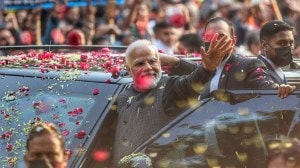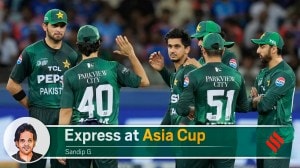The Artist as an Activist
Multimedia artist Nalini Malani on breaking out of the painting frame,creating videoplays and listening to our Cassandras.
Multimedia artist Nalini Malani on breaking out of the painting frame,creating videoplays and listening to our Cassandras.
In Mumbai-based artist Nalini Malanis works,the sub-culture of oppression and violence that dogs the marginalised comes alive with a persistence. One of Indias most prominent contemporary artists,Malanis work constantly updates itself and engages technology with artistic practices. Since the late Sixties,Malani has not only experimented with traditional mediums like canvas and paper,but has also been one of the pioneers in the country of what she calls videoplays. The 60-something artists works have found recognition in various prestigious exhibitions and museums in India and outside,including the ongoing Documenta 13 in Kassel,Germany. In an interview with Paromita Chakrabarti,Malani talks about her early years in France,her symbiotic relationship with literature and why,as an artist,she cannot ignore socio-political issues. Excerpts:
Tell us about the ongoing In Search of Vanished Blood at Documenta (13) in Germany.
In Search of Vanished Blood,is a part of my interest in the Cassandra complex on which I have been working for the last seven years in different mediums. The fact that the world is moving in a dangerous direction,in the context of orthodox politics,ecology,and female suppression,is frightening. Unfortunately,within this situation,our male-dominated society is still refusing to listen to the Cassandra part of our psyche the female element that is in all of us. Cassandras warning,and the openness for a different solution,is blown away in the wind.
In Kassel,I made a site-specific,six-channel video/shadow play that is projected 360 degrees above the visitors in the manner of a video frieze. It is a room-filling artwork where the projections touch the ceiling at a height of 12 metres. There are five human size Mylar cylinders with reverse painted images that rotate very slowly,casting shadows by the light of the video images. So the layering is very dense. It is 11-minute-long and I have composed a sound piece for it. Large groups of people can enjoy the work simultaneously.
Since the opening in June,the reactions have been overwhelming in the press,on YouTube and in the hundreds of emails. I have had well over a 100 international exhibitions,and various international museum solo shows,but never have I received such a massive and contents-based response. It is overwhelming to see what the power of art can still be.
You are one of the pioneers of video installations in India. What motivated you to turn to videos in the early days?
In the late Sixties and early Seventies,as a young artist,I was very motivated to experiment with film. For me,film language was able to express much more of the psychological landscape than any other medium. Even in the period from 1972 till 1990,when I did not make films or video due to financial constraints,the filmic look dominated my paintings. It was around 1990 that I literally broke out of the painting frame. The political circumstances had taken an orthodox turn,where women are usually the first one to suffer. In order to get a wider audience to listen to ones ideas,I started to use the cheaper version of film the video and used other media such as theatre,ephemeral wall drawings,or a combination of them. I dont call these works video installations but videoplays.
How difficult was it to attempt something so unexplored? What was the reaction of your contemporaries and your audience?
Logistically,it was a nightmare,even in the late Nineties. My video play Remembering Toba Tek Singh needed four projections in sync and 12 monitors. When exhibited in January 1999 at the Coomaraswamy Hall of the Prince of Wales Museum,in Mumbai,the sponsor was Philips but they had no projectors in India and wanted to fly them in from Singapore. Finally,they rented another brand and put the Philips logo on the machines. As for the syncing,this did not exist in our country in those days,two assistants sat the whole day behind the screens to monitor it manually when one of the projections got out of sync.
The reaction of the audience to this videoplay was overwhelming. The idea was to draw the attention of a wider public to Indias nuclear experiments. In just 10 days,almost 25,000 people visited it. Many watched the cycle several times and were vividly involved with the political discussions about the pros and cons of becoming a nation with nuclear weapons. My fellow artists,especially women artists,were very supportive and interested in these new works. Most art critics were not interested and many did not see this work,as video art and political discussions were anathema to them.
At the start of your career,you spent a lot of time in France. How did those years shape your artistic sensibilities?
I arrived in Paris soon after the 1968 student revolution. The art academy was still closed. It was a highly charged intellectual atmosphere in France and it gave me the opportunity to get involved in left wing politics that were spearheaded by the existentialists Simone de Beauvoir and Jean Paul Satre. I also spent a lot of time at the Cinémathèque Française to study the history of cinema and also the more avant-garde movements like Nouvelle Vague. So definitely being in France at a young age in 1970/72 had a lifelong impact on my artistic practice.
Is it a conscious decision that most of your works comment on socio-political issues?
In our society,the social and economic conditions are tragic and dismal for women,the minorities and the poor. I am forced to react to this in my art. I would almost say: how can one,as a sensitive artist,stand aside and turn a blind eye? I never followed a political agenda but from the start I made art that was always based on serving the purpose of human dignity.
Have you ever faced censure? How do you react to restrictions on art?
When using a provocative form,language/content,one often risks the possibility of censorship,whether it is based on sexual exposure,political opinion etc. As such,my work always operates on the edge. However,growing up in a country where many political and religious groups react very sensitively,I try to layer my works in a manner where the content is understood in a specific context. For example,when in the video play Remembering Toba Tek Singh two monitors show the birth of an Indian and a white baby,there was huge interest from male Indian visitors,but within the context there was no problem as it showed the naked female body and not the erotic. Even my critiquing of the government nuclear enterprise in a national museum did not lead to any negative provocations. I know that there are restrictions but I play with it in a creative manner,so that I can still exhibit my work in most cases. This decision on what and how you show is interlinked with the audience you want to reach.
A lot of your work is also a response to literature…
Understanding life through the eyes of a writer has been my second passion after the visual arts. I almost always include my readings in the artwork,within the different media I use. Looking at my bookshelves it is difficult to reduce its impact to a few titles. But definitely,works by Bertolt Brecht,Mantos short stories and some books like Christa Wolfs Cassandra are ones that I need to carry around with me for years.
What are you working on now?
After working for a few years on the subject of Cassandra that has resulted in a number of works,I am now in limbo. At such times,I read a lot and listen to my inner self. I cant predict how long this period of silence lasts,however I can tell you I can already feel the first vibrations of the next storm in the near distance.
You are a painter,a multimedia and theatre artist and often a writer. Which of these mantles are you most at ease with?
I would say none. Just call me an artist.
(Who knows) in which format I will express myself tomorrow?
Photos


- 01
- 02
- 03
- 04
- 05





























